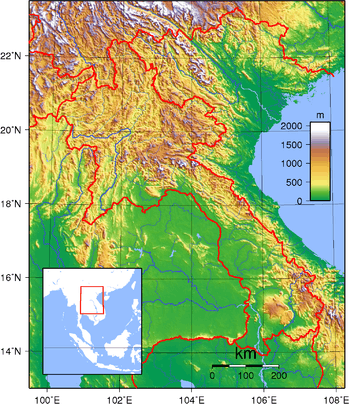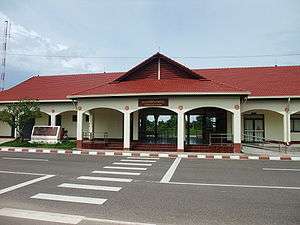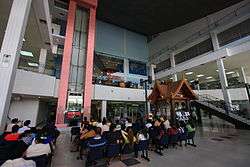Transport in Laos
This article concerns systems of transportation in Laos. Laos is a country in Asia, which possesses a number of modern transportation systems, including several highways and a number of airports. As a landlocked country, Laos possesses no ports or harbours on the sea, and the difficulty of navigation on the Mekong means that this is also not a significant transport route.
Geography and transport limits

Because of its mountainous topography and lack of development, Laos has few reliable transportation routes. This inaccessibility has historically limited the ability of any government to maintain a presence in areas distant from the national or provincial capitals and has limited interchange and communication among villages and ethnic groups.
The Mekong and Nam Ou are the only natural channels suitable for large-draft boat transportation, and from December through May low water limits the size of the draft that may be used over many routes. Laotians in lowland villages located on the banks of smaller rivers have traditionally traveled in pirogues for fishing, trading, and visiting up and down the river for limited distances.
Otherwise, travel is by ox-cart over level terrain or by foot. The steep mountains and lack of roads have caused upland ethnic groups to rely entirely on pack baskets and horse packing for transportation.
The road system is not extensive. A rudimentary network begun under French colonial rule and continued from the 1950s has provided an important means of increased intervillage communication, movement of market goods, and a focus for new settlements. In mid-1994, travel in most areas was difficult and expensive, and most Laotians traveled only limited distances, if at all. As a result of ongoing improvements in the road system started during the early 1990s, it is expected that in the future villagers will more easily be able to seek medical care, send children to schools at district centers, and work outside the village.
Railways
| Rail transport in Laos | |
|---|---|
 Thanaleng Station near Vientiane, Laos's only railway station | |
| Operation | |
| National railway | State Railway of Thailand |
| Statistics | |
| Ridership | ? |
| System length | |
| Total | 3.5 kilometres (2.2 mi) |
| Electrified | 0 km (0 mi) |
| High-speed | 0 km (0 mi) |
| Track gauge | |
| Main | 1,000 mm (3 ft 3 3⁄8 in) |
| Features | |
| No. tunnels | 0 |
| No. stations | 1 |
| Highest elevation | on Thai–Lao Friendship Bridge |
Rail transport does not play a significant part in Laos's transport sector, since the country largely lacks the required infrastructure. A short portage railway, the Don Det – Don Khon narrow gauge railway, was built by the French while Laos was a part of French Indochina. The railway crossed over the islands of Don Det and Don Khon, enabling vessels, freight and passengers to travel along the Mekong River. The railway was abandoned and fell into disrepair, although some of the infrastructure is still in place.[1]
In the late 1920s, work began on the Thakhek – Tan Ap railway, that would have run between Thakhek, Khammouane Province and Tân Ấp Railway Station, Quảng Bình Province, Vietnam through the Mụ Giạ Pass. However, the scheme was eventually aborted in the 1930s.
Link to Thailand
In January 2007 work began on a 3.5 km extension of the metre-gauge State Railway of Thailand network across the Thai–Lao Friendship Bridge to Thanaleng Railway Station, a new passenger and freight terminal in Dongphosy village, 20 km east of Vientiane.[2] Test trains began running on July 4, 2008,[3] and Princess Maha Chakri Sirindhorn of Thailand formally inaugurated the line on March 5, 2009.[4][5] As of November 2010, Lao officials plan to convert the station into a rail cargo terminal for freight trains, allowing cargo to be transported from Bangkok into Laos at a lower cost than would be possible with road transport.[6]
Link to Vietnam
In 2007, the Laotian Ministry of Transportation entered into discussion with Vietnam to discuss the possibility of opening a new railway line from Thakhek in Laos through the Mụ Giạ Pass to Tân Ấp Railway Station in Vietnam's Quảng Bình Province, on the North–South Railway. The proposed line would continue to the coast at Vung Ang, a port in Hà Tĩnh Province, which would provide landlocked Laos with access to the South China Sea. According to plans established by ASEAN, the line may also be extended via Thakhek all the way to the Laotian capital Vientiane. Both Laos and Thailand have expressed interest in the project as a shorter export gateway to the Pacific Ocean.[7][8]
By 2012, the Thakhek project was not in the news anymore; but a project for another, somewhat more southern, line to Vietnam, now from Savannakhet, was announced instead. An agreement for the construction of this 220-kilometre-long, $5 billion line, was signed on Nov 5, 2012 with the Malaysian company called Giant Consolidated Limited. The work is supposed to begin in 2013 and be completed in 4 years.[9][10]
Link to China
Laos has a long history of negotiating with China regarding the possibility of a join railway project.[11]
In October 2010, plans were announced for a 530 km standard gauge[9] railway linking Vientiane to Xishuangbanna, in Yunnan province in China.[12] Construction was expected to begin in 2011, for completion in 2014.[13][14] There were plans to extend this railway south from Vientiane to Bangkok.[15] However, in April 2011 it was reported that construction of the railway has been postponed indefinitely, while the Chinese Minister of Railways Liu Zhijun has been arrested on corruption charges.[16]
In October 2012, it was announced again that an agreement with China about the construction of a railway from Vientiane to the Chinese border is to be signed "within days". The project cost is quoted at $7 bln, and the construction will be done by Chinese companies. The ground-breaking ceremony was planned for November 2012, and the completion of the project was expected by 2017.[11] In November 2012, the Laotian press was reporting that the money for the construction of the railway would be borrowed from the EXEM Bank of China; the construction would be started in 2013, and complete in 2018.[9]
The rail link will go through Yunnan province, linking together Kunming, China with Vientiane, Laos via Bangkok, Thailand to Dawei, Myanmar.[17] On February 23, 2013, part of the new railway line started operations. It spans from Yuxi, south of Kunming, capital of China’s southern Yunnan province, to Mengzi on the route to the Vietnamese border, and is mainly intended for freight transport with a maximum speed of 120 km/h. The new line replaces the 100-year-old, 854 kilometer Kunming-Haiphone line, which had a speed of just 30 km/h.[18]
On 2 December 2015, Laos with China officially began about the construction of a railway from Vientiane to the Chinese border. The railway will stretch 427 km, from the Laos-China borderline in Phongsaly Province to Vientiane Capital. The rail will be connected with the new railway bridge spanning the Mekong between Vientiane and Thailand's Nongkhai Province. The total project cost is estimated at 38.7 billion yuan (over US$6 billion), which is about 90.6 million yuan (approx. US$14 million) per kilometre. China will be responsible for 70 per cent of the total investment, while Lao will bear the remainder.
Highways
In Laos, there are 21,716 km of highway, of which 9,673.5 km are paved, leaving 12,042.5 km unpaved. Driving in Laos is on the right.
Laos has constructed a new highway connecting Savannakhet to the Vietnamese border at Lao Bao, with funding coming from the Japanese government . This has greatly facilitated travelling across Laos. This highway can now be traversed in a few hours, while in 2002 the trip took over 9 hours along a very bumpy (and scenic) route.
Laos is connected across the Mekong to Thailand by First and Second Thai-Lao Friendship Bridges. Vientiane is linked to Udon Thani using the First Friendship Bridge. The Third Thai-Lao Friendship Bridge began construction in March 2009 linking Nakhon Phanom province in northeastern Thailand and Khammouan province in Laos. It was completed on November 11, 2011.
Laos opened a highway connection to Kunming in April 2008. The Fourth Thai-Lao Friendship Bridge is under construction and opened to the public on 11 December 2013 linking Kunming to Bokeo, Laos and Chiang Rai. It reduces the travel time to 5 hours. This is a cooperation between Thailand, China and Laos.
Water transport
About 4,587 km of navigable water routes exist in Laos, primarily the Mekong and its tributaries. There is an additional 2,897 km, which is sectionally navigable by craft drawing less than 0.5 m.
In terms of sea travel, Laos has a merchant marine consisting of 1 cargo ship of 2,370 gross register tons (GRT).
Pipelines
Laos has 136 km of pipeline for transport of petroleum products.
Airports

Laos possesses 52 airports, of which 9 have paved runways, and 43 do not. Of the airports with paved runways, only Wattay International Airport has runway length over 2,438 m which is necessary to accommodate jumbo jets. Of the remainder, four have runways 1,524 to 2,437 m length, and a further four of lengths between 914 and 1,523 m.
Of the airports without paved runways, 1 has runways of length above 1,524m, 17 have runway lengths between 914 and 1,523 m, leaving 25 with length below 914 m.
See also
External links
- UN Map of Laos
- Map of railways in Laos, Cambodia, and Vietnam – does not show Thailand or China
References
- ↑ The only railway (ever) in Laos The International Steam Pages
- ↑ "Laos link launched". Railway Gazette International. 2007-03-01.
- ↑ "Testing takes train into Laos". Railway Gazette International. 2008-07-07.
- ↑ "Inaugural train begins Laos royal visit". Railway Gazette International. 2009-03-05.
- ↑ Andrew Spooner (2009-02-27). "First train to Laos". The Guardian. Retrieved 2011-03-13.
- ↑ Rapeepat Mantanarat (2010-11-09). "Laos rethinks rail project". TTR Weekly. Retrieved 2011-03-13.
- ↑ "Fact Sheet: The Singapore–Kunming Rail Link Project" (PDF). ASEAN. 2007-09-26. Retrieved 2011-01-05.
- ↑ "The Study on the Development Plan of Thakek-Vung Ang Gateway between Lao PDR and Vietnam" (PDF). Engineering and Consulting Firms Association, Japan Development Institute (JDI). March 2010.
- 1 2 3 Laos-China railways ready to roll, 2012-11-16
- ↑ Laos to build railway to Vietnam\, 2012-11-14
- 1 2 Laos Says China to Finance Rail Link, The Wall Street Journal, 2012-10-24
- ↑ "NEW CHINA-LAOS LINK". Railways Africa. Retrieved 2010-11-09.
- ↑ "LAOS LINK WITH CHINA". Railways Africa. 2010-12-12. Retrieved 2010-12-12.
- ↑ "Railway Gazette: China's horizons extend southwards". 2011-01-06. Retrieved 2011-01-06.
- ↑ "Railway Gazette: Cross-border construction soon". Retrieved 2011-02-27.
- ↑ "High Speed Railway Delay". Radio Free Asia. Retrieved 2011-06-30.
- ↑ "China-Laos railway to commence". Investvine.com. Jan 9, 2013. Retrieved Jan 10, 2013.
- ↑ "China-ASEAN rail network advances". Investvine.com. 2013-02-24. Retrieved 2013-02-24.
![]() This article incorporates public domain material from the CIA World Factbook website https://www.cia.gov/library/publications/the-world-factbook/index.html.
This article incorporates public domain material from the CIA World Factbook website https://www.cia.gov/library/publications/the-world-factbook/index.html.
